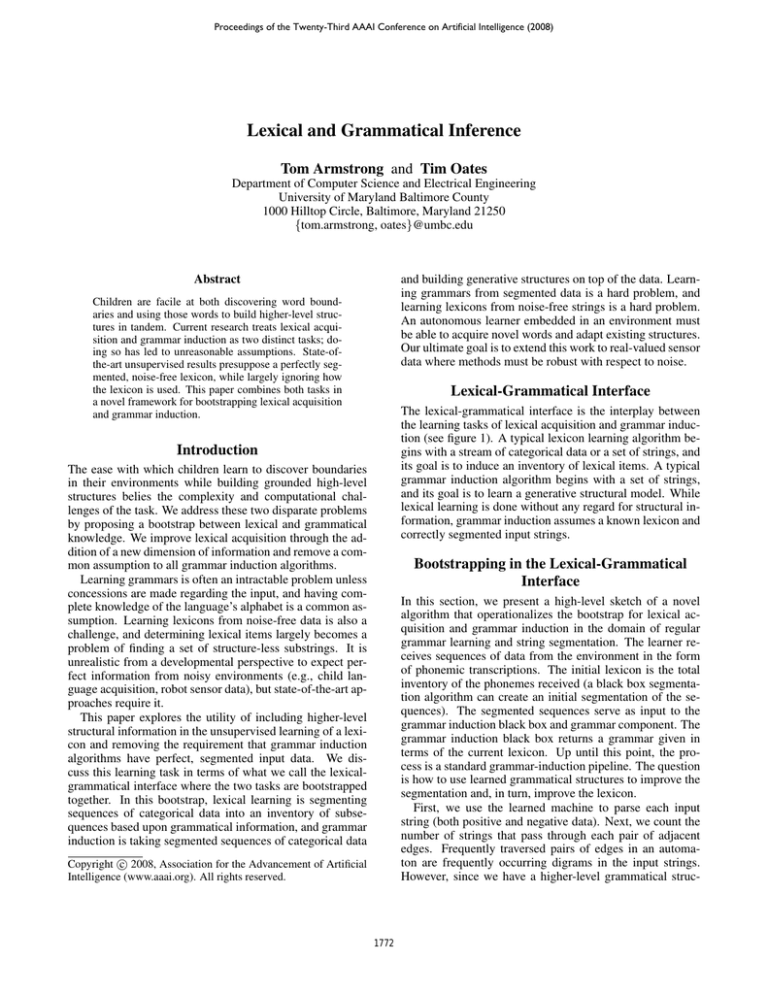
Proceedings of the Twenty-Third AAAI Conference on Artificial Intelligence (2008)
Lexical and Grammatical Inference
Tom Armstrong and Tim Oates
Department of Computer Science and Electrical Engineering
University of Maryland Baltimore County
1000 Hilltop Circle, Baltimore, Maryland 21250
{tom.armstrong, oates}@umbc.edu
Abstract
and building generative structures on top of the data. Learning grammars from segmented data is a hard problem, and
learning lexicons from noise-free strings is a hard problem.
An autonomous learner embedded in an environment must
be able to acquire novel words and adapt existing structures.
Our ultimate goal is to extend this work to real-valued sensor
data where methods must be robust with respect to noise.
Children are facile at both discovering word boundaries and using those words to build higher-level structures in tandem. Current research treats lexical acquisition and grammar induction as two distinct tasks; doing so has led to unreasonable assumptions. State-ofthe-art unsupervised results presuppose a perfectly segmented, noise-free lexicon, while largely ignoring how
the lexicon is used. This paper combines both tasks in
a novel framework for bootstrapping lexical acquisition
and grammar induction.
Lexical-Grammatical Interface
The lexical-grammatical interface is the interplay between
the learning tasks of lexical acquisition and grammar induction (see figure 1). A typical lexicon learning algorithm begins with a stream of categorical data or a set of strings, and
its goal is to induce an inventory of lexical items. A typical
grammar induction algorithm begins with a set of strings,
and its goal is to learn a generative structural model. While
lexical learning is done without any regard for structural information, grammar induction assumes a known lexicon and
correctly segmented input strings.
Introduction
The ease with which children learn to discover boundaries
in their environments while building grounded high-level
structures belies the complexity and computational challenges of the task. We address these two disparate problems
by proposing a bootstrap between lexical and grammatical
knowledge. We improve lexical acquisition through the addition of a new dimension of information and remove a common assumption to all grammar induction algorithms.
Learning grammars is often an intractable problem unless
concessions are made regarding the input, and having complete knowledge of the language’s alphabet is a common assumption. Learning lexicons from noise-free data is also a
challenge, and determining lexical items largely becomes a
problem of finding a set of structure-less substrings. It is
unrealistic from a developmental perspective to expect perfect information from noisy environments (e.g., child language acquisition, robot sensor data), but state-of-the-art approaches require it.
This paper explores the utility of including higher-level
structural information in the unsupervised learning of a lexicon and removing the requirement that grammar induction
algorithms have perfect, segmented input data. We discuss this learning task in terms of what we call the lexicalgrammatical interface where the two tasks are bootstrapped
together. In this bootstrap, lexical learning is segmenting
sequences of categorical data into an inventory of subsequences based upon grammatical information, and grammar
induction is taking segmented sequences of categorical data
Bootstrapping in the Lexical-Grammatical
Interface
In this section, we present a high-level sketch of a novel
algorithm that operationalizes the bootstrap for lexical acquisition and grammar induction in the domain of regular
grammar learning and string segmentation. The learner receives sequences of data from the environment in the form
of phonemic transcriptions. The initial lexicon is the total
inventory of the phonemes received (a black box segmentation algorithm can create an initial segmentation of the sequences). The segmented sequences serve as input to the
grammar induction black box and grammar component. The
grammar induction black box returns a grammar given in
terms of the current lexicon. Up until this point, the process is a standard grammar-induction pipeline. The question
is how to use learned grammatical structures to improve the
segmentation and, in turn, improve the lexicon.
First, we use the learned machine to parse each input
string (both positive and negative data). Next, we count the
number of strings that pass through each pair of adjacent
edges. Frequently traversed pairs of edges in an automaton are frequently occurring digrams in the input strings.
However, since we have a higher-level grammatical struc-
c 2008, Association for the Advancement of Artificial
Copyright Intelligence (www.aaai.org). All rights reserved.
1772
SA
Lexicon
Phoneme
Sequences
Segmentation
Changes
Segmented
Sequences
GI
Grammar
Environment
Novel
Utterances
Figure 1: Learning in the Lexical-Grammatical Interface (SA and GI are segmentation and grammar learning black boxes
selected based upon the type of sequences and class of languages, respectively)
ture, instead of indiscriminately merging digrams in strings,
we have the condition that the same edges must be traversed
for a merge to occur. Edge-pair selection proceeds greedily and the most frequent edge pair is used to resegment the
positive and negative data. The bootstrap continues with the
strings in terms of a new lexicon. This complete approach
to grammar learning begins with an overly general grammar
and proceeds through the space of possible automata to an
overly specific grammar (i.e., one production for each string
of positive data). The algorithm returns the grammar with
the global minimum lexicon size.
We evaluated the bootstrap using natural language data
and the state of the art in grammar induction. The grammar induction community has a series of benchmark languages for comparing learning algorithms: L1 through L151
(Tomita 1982; Dupont 1994). Our unsupervised learning algorithm successfully discovers the lexicons and grammars
of many test languages. The difficulties with our algorithm and framework result from cases that are challenges
for grammar induction algorithms and lexical learning algorithms.
languages can replace RPNI. These results will define a new
class of learnable formal languages and will shed light on
the learnability of natural languages.
Next, we will harness the generative power of the grammar and lexicon to create novel utterances. A learner embedded in an environment can then be used to experiment
with language generation. This information can be used during edge-merge selection. The intuition is that while the automata’s structures are different, the surface forms of the utterances are the same. Finally, we will extend our current
results using categorical data to time series data and spoken
natural language data.
References
Batchelder, E. O. 2002. Bootstrapping the lexicon: A computational model of infant speech segmentation. Cognition
83(2):167–202.
Brent, M. 1999. An efficient, probabilistically sound algorithm for segmentation and word discovery. Machine
Learning 34:71–105.
Cohen, P. R.; Heeringa, B.; and Adams, N. M. 2002.
Unsupervised segmentation of categorical time series into
episodes. In ICDM, 99–106.
Dupont, P. 1994. Regular grammatical inference from
positive and negative samples by genetic search: the gig
method. In ICGI ’94: Proceedings of the Second International Colloquium on Grammatical Inference and Applications, 236–245. London, UK: Springer-Verlag.
Nevill-Manning, C. G., and Witten, I. H. 1997. Identifying hierarchical structure in sequences: A linear-time algorithm. Journal of Artificial Intelligence Research 7:67.
Tomita, M. 1982. Dynamic construction of finite automata
from examples using hill climbing. In Proceedings of the
4th Annual Cognitive Science Conference, 105–108.
Wolff, J. G. 1975. An algorithm for the segmentation of an
artificial language analogue. British Journal of Psychology
66:79–90.
Related and Future Work
The seminal work of Gerry Wolff that has developed into
the compression as computing paradigm (Wolff 1975) inspires this work. The approaches most similar to this work
treat acquiring a lexicon as an unsupervised learning problem with a simplicity bias (Nevill-Manning & Witten 1997;
Cohen, Heeringa, & Adams 2002; Brent 1999; Batchelder
2002).
Future work will proceed in three directions. First, we
will focus on the theoretical boundaries of the lexicalgrammatical bootstrap. That is, we will explore the classes
of languages that are lexical- and grammatical-learnable in
the Chomsky hierarchy. As the grammar induction component is a black box, learning algorithms for more complex
1
Canonical deterministic finite automata and data are available from http://www.irisa.fr/symbiose/people/
coste/gi benchs.html
1773





